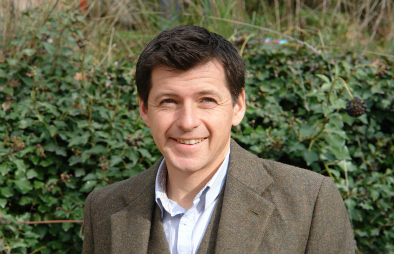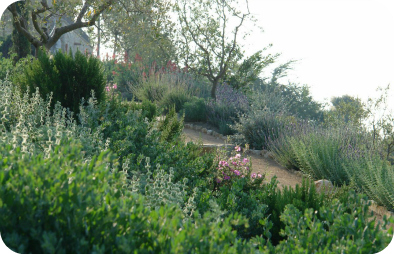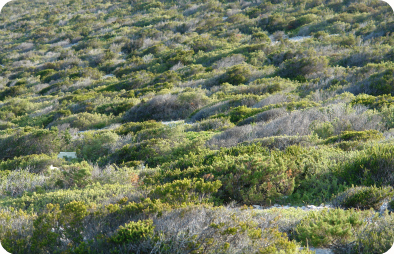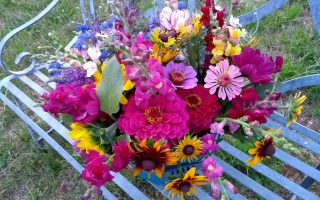Gardening in a Mediterranean climate

Gardening in a Mediterranean climate offers several restrictions in terms of what will and what won’t survive due to the hot summers, heavy rainfall at concentrated times of the year and the maritime winds that dry the air and soil. Taking inspiration from the surrounding landscape and seeing what works– with no input at all from man– can offer valuable lessons and prove that it is possible to produce a truly sustainable garden inspired by nature.
The use of water in gardens is a tricky subject in the Mediterranean climate. Violent storms at certain times of the year result in rapid run-off streams which have an important effect on the natural landscapes. This is also an area that is rich in natural springs, from mountain lakes to the rivers that run down to the Mediterranean Sea. Water softens what is otherwise a hard landscape, and gives it a calming quality. You only have to have experienced one of the natural grottos with moss covered walls to appreciate the beauty and contrast this can provide. Using water in the garden to recreate this natural quality rather than for irrigation purposes can have magical results.

Despite common perceptions it is possible to have a beautiful garden with no irrigation which gives several advantages, some more obvious than others. Less water means less weeds, and in turn less growth therefore less pruning thus keeping maintenance to a minimum. It is possible to have a machine-free maintenance programme eliminating the need for hedge trimmers, mowers and blowers other than a bi-annual strim. People tend to forget that Mediterranean plants don’t like water. If they are over-watered the longevity of the plant is threatened, something often seen in lavender plantings.
With the increasing number of tiger mosquitoes in the area, less water also serves to discourage them from reproducing as –unlike the traditional mosquito that lays its eggs in stagnant water– this new breed of mosquitoes likes nothing better than damp grass.
Although the desire for a nice green lawn is understandable, it is important to realize that it is in fact out of sync with its natural surroundings in this climate, and clashes considerably with the more subdues tones of the landscape in which it is situated.

When it comes to planting look again to what nature can teach us. In Mediterranean areas there are typically three main landscapes from which to draw inspiration.
- Firstly the wide open Steppe areas. These are the most sparsely vegetated, as grazing and harsh weather conditions and poor thin soil play their part. Low level carpeting plants thrive due to their ability to constantly regenerate and reproduce. Typically in this environment there will be hardy grasses, thymes and other ground cover, bulbs and sub shrubs. All of these offer interesting and colourful alternatives to the traditional lawn.
- Secondly we have the Maquis areas consisting mainly of shrubs and sub-shrubs. The soil is impoverished, often harsh climates and strong winds keep plants from reaching their full potential, resulting in stunted growth. Yet the diversity and tenacity of plants in this area is amazing and it is from these natural phenomena that we should take our inspiration using plants that are adapted to these conditions.
- Finally the Garrigue areas which are beautiful natural wastelands. Often suffering from forest fires, the trees rarely take hold of the land. The subsequent vegetation is richer with deeper soil and less frequent grazing, Shrubs and small isolated trees (Pistacius lentiscus, Myrtus communis, Phillyrea angustifolia) make up an impenetrable thorny scrubland, that gives the perfect lesson in how to create an attractive hedge that sits comfortably in the local environment and extends the view of the garden rather than a strong block of leylandii or laurier rose that cuts it short.When planting it is best to plant small in the autumn. This eliminates the need for watering over the long hot summer and gives the plants a chance to establish root growth in time for the following summer when they will have adapted to their new location and survive. Plant choice is incredibly important. If a plant is sick rather than treat it with chemicals, replace it with another plant that will thrive. Don’t plant in blocks of one species as we were once taught to do – if that plant suffers from an overly cold winter or hot summer you will be left with a gaping hole in the garden. Use an evergreen shrub layer to cover the surface and prevent weed growth, with perennials, bulbs and deciduous species rising through to give year-round colour and interest.
Finally once the plants are in the ground think about the surrounding landscape it has come from and mulch accordingly, for example gravel (garrigue, maquis or steppe areas) or composted bark (woodland areas).
The aim is to create a landscape within a garden that is in harmony with its surroundings and gives the feeling of peace, sitting comfortably in the space whilst giving the user a sense of continuity.
• With thanks to James Basson
ames Basson is an international garden designer, based in Monaco who specialises in dry, sustainable gardens that mix contemporary design with traditional skills. His designs have received international recognition and numerous awards around the world – at the ‘RHS Chelsea Flower Show’ and the ‘RHS Hampton Court Flower Show’ in the UK; at the ‘Gardening World Cup’ in Japan and at the ‘PHS Philadelphia Flower Show’. Two Gold Medals highlight the awards, received for the garden ‘After the Fire’ at the ‘Chelsea Flower Show’ and for the garden ‘Dulce et Decorum est’ at the ‘Gardening World Cup’.
www.scapedesign.com
Share to: Facebook Twitter LinkedIn Email
More in garden, land, people, river, summer
Leave a reply
Your email address will not be published. Required fields are marked *



